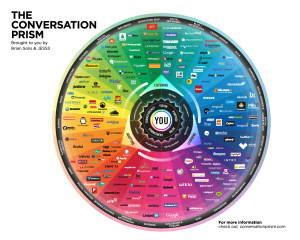Brian Solis and his new conversation prism. Useful or just confusing?
 Brian Solis has just published a new version of his conversation prism. You have probably used one of the previous versions as the title graphic for your presentation on social media – it has almost become the default here. I used to use it as such, but then I stopped. I did this after someone attending a workshop said “whoa – stop right there. That’s the problem.” I asked what she meant and she explained that this picture simply illustrated why she was intimidated by social media – multiple segments, hundreds of bright shiny tools you need to be familiar with.
Brian Solis has just published a new version of his conversation prism. You have probably used one of the previous versions as the title graphic for your presentation on social media – it has almost become the default here. I used to use it as such, but then I stopped. I did this after someone attending a workshop said “whoa – stop right there. That’s the problem.” I asked what she meant and she explained that this picture simply illustrated why she was intimidated by social media – multiple segments, hundreds of bright shiny tools you need to be familiar with.
I think she was right. Diagrams such as this perpetuate a way of thinking which, increasingly, I try and lead people away from, which is the idea that social media is both complicated and defined by a dazzling array of tools. This imagined complexity stems from the desire to understand social media in the way which we understood traditional media – i.e. as a channel and message challenge. If you look at it this way you see lots of channels (tools) and a vast array of potential messages (conversations). But social media is not a channel and message challenge (as I have pointed out in a previous response to an Altimeter Group initiative) it is a behaviour identification and response challenge and there are only four of these (in effect digital spaces) you need to respond to:
- People saying nice things about your business
- People complaining about your business
- People asking questions for which your business provides an answer
- People indicating a willingness to help you make your business better
Unfortunately this doesn’t make for such a pretty graphic, but understanding this does actually help businesses understand both how social media works and also how they need to address this space. And, in-so-far as tools are important here, the most important ones are listening tools and, astonishingly enough, none of those feature in Brian’s prism. How can you have a conversation without first listening?
For more thoughts on why social media is about process, not about tools check out Social Media and The Three Per Cent Rule: how to succeed by not talking to 97 per cent of your audience.

5 comments